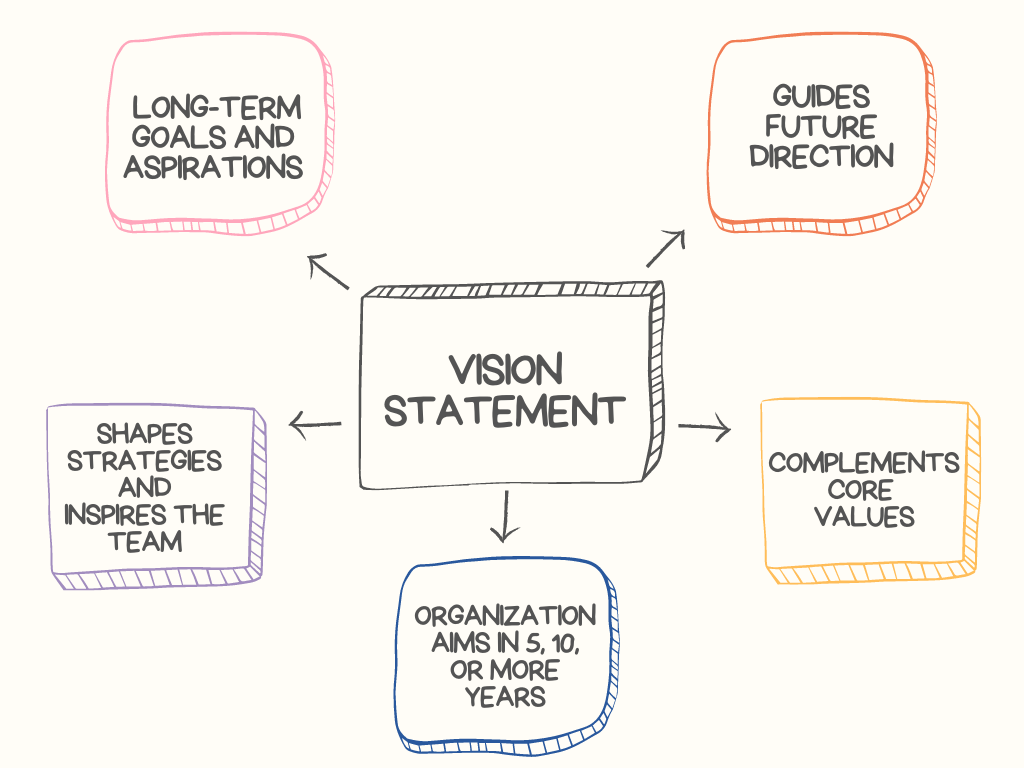Creating a vision statement might seem challenging at first, but it’s one of the most important steps in planning your business’s future. A vision statement isn’t just a set of words; it’s a clear message that defines where you want your business to go. It lays out your long-term goals and provides direction for everyone on your team.
Whether you’re starting a new business or managing one that’s been around for a while, having a clear vision statement helps you make decisions, stay focused on your goals, and ensure that everyone is working towards the same objectives.
It reflects your goals for the business, shapes the company culture, and motivates everyone to move forward together towards the future you envision.
What Is a Vision Statement?
A vision statement defines your organization’s long-term goals and aspirations. It provides clear guidance on where you want your company to be in the future, helping to shape strategies and inspire everyone involved. While your core values represent the principles that guide your organization, your vision statement paints a picture of what you hope to achieve over the next five, ten, or more years.
Essentially, it answers questions like:
- Where do we want to go?
- What do we want to become?
- What will success look like for us?
By outlining your vision, you create a sense of purpose that drives your organization forward. For example, Amazon’s vision is “to be Earth’s most customer-centric company, where customers can find and discover anything they might want to buy online.”

A vision statement does more than just inspire; it aligns everyone within the organization towards a common goal. This unified focus can have a significant impact on your company’s long-term success.
It’s important to take the time to develop a vision that truly reflects your aspirations. When done right, a vision statement not only sets the direction for your business but also motivates your team to work together to achieve that future.
The Importance of a Vision Statement
Why is a vision statement so important? This is your company’s guide for the future. It unites your team with a shared goal, and offers direction when things are uncertain. A well-crafted vision statement motivates and inspires your employees, attracts partners who share your goals, and connects with customers who believe in what you stand for.
Additionally, a vision statement is crucial for strategic planning. By outlining where you want to go, it helps you plan the steps needed to reach that goal. This makes it easier to set priorities and ensures that everyone in your organization is focused on the same objectives.
Key Elements of a Powerful Vision Statement
An effective vision statement is:
- Clear: Easy to understand.
- Inspirational: Motivates and engages.
- Future-Oriented: Focused on long-term goals.
- Concise: Brief but impactful.
Steps to Writing a Vision Statement
Now that you know why a vision statement is important and what makes it effective, let’s go through the steps to create one.
Step 1: Identify the Purpose and Core Values
Begin by clarifying your organization’s purpose—what motivates you? What are the core values that guide your actions? These fundamental principles should be at the center of your vision statement. This step often involves looking inward and gathering input from different people involved in your organization to ensure the vision accurately reflects what you stand for.
Step 2: Envision the Future
Picture your organization ten or twenty years from now. What does it look like? What milestones are you proud of achieving? This step is about thinking big and setting ambitious long-term goals.
It’s your chance to imagine where you want your organization to go and how it will evolve over time. Aim for a vision that challenges and inspires, So you can push your organization towards growth and development.
Step 3: Be Ambitious Yet Realistic
It’s great to aim high, but your vision should also be realistic. Strive for goals that are ambitious yet achievable. Finding this balance ensures that your vision inspires and motivates your team without setting them up for unrealistic expectations. This way, your vision will be both exciting and attainable, keeping everyone focused and driven.
Step 4: Keep It Simple and Memorable
Simplicity is essential. Your vision statement should be easy for everyone in your organization to remember and explain. Use straightforward language and keep your sentences clear and concise. This makes it easier for your team to connect with and recall the vision as they work towards it.
Step 5: Seek Input and Collaborate
Don’t create your vision statement alone. Involve key stakeholders such as employees, leaders, and even customers. Collaborating with these groups ensures that the vision reflects a broad perspective and resonates with everyone involved in the organization. This inclusive approach helps create a vision that everyone can support and work towards.
Step 6: Refine and Finalize
Once you have a draft, take time to review and refine it. Make sure it aligns with your mission statement and truly reflects your long-term goals. This process may involve multiple revisions, but taking the time to perfect it ensures that your vision is clear, accurate, and effective.
25 Vision Statement Examples to Inspire You
Looking for inspiration? Here are 25 vision statements from successful companies that have nailed it:
- Tesla: “To create the most compelling car company of the 21st century by driving the world’s transition to electric vehicles.”
- Google: “To provide access to the world’s information in one click.”
- Microsoft: “To help people and businesses throughout the world realize their full potential.”
- Nike: “To bring inspiration and innovation to every athlete* in the world.”
- LinkedIn: “Create economic opportunity for every member of the global workforce.”
- Amazon: “To be Earth’s most customer-centric company, where customers can find and discover anything they might want to buy online.”
- IKEA: “To create a better everyday life for the many people.”
- Disney: “To entertain, inform, and inspire people around the globe through the power of unparalleled storytelling.”
- Starbucks: “To inspire and nurture the human spirit – one person, one cup, and one neighborhood at a time.”
- TED: “Spread ideas.”
- Oxfam: “A just world without poverty.”
- Patagonia: “We’re in business to save our home planet.”
- Apple: “To make the best products on earth and to leave the world better than we found it.”
- Samsung: “Inspire the world, create the future.”
- Walmart: “To save people money so they can live better.”
- Ford: “To become the world’s most trusted company, designing smart vehicles for a smart world.”
- Coca-Cola: “To refresh the world in mind, body, and spirit.”
- McDonald’s: “To be the world’s best quick-service restaurant experience.”
- Netflix: “To entertain the world.”
- Sony: “To be a company that inspires and fulfills your curiosity.”
- Adidas: “To be the best sports company in the world.”
- Twitter: “To give everyone the power to create and share ideas and information instantly, without barriers.”
- Facebook: “To give people the power to build community and bring the world closer together.”
- Intel: “If it is smart and connected, it is best with Intel.”
- Uber: “We ignite opportunity by setting the world in motion.”
How These Companies Write Their Vision Statements and What It Shows
Tesla: “To create the most compelling car company of the 21st century by driving the world’s transition to electric vehicles.”

Tesla’s vision is bold and forward-thinking. It reflects the company’s ambition to lead the global shift toward sustainable energy and revolutionize the automotive industry. By positioning itself as the “most compelling car company,” Tesla emphasizes its role in innovation and market leadership.
The focus on “driving the world’s transition to electric vehicles” underlines its commitment to environmental responsibility and its mission to redefine transportation.
Google: “To provide access to the world’s information in one click.”
Google’s vision is straightforward and user-focused. It encapsulates the company’s mission to make information universally accessible and useful, emphasizing simplicity and efficiency.
The phrase “in one click” highlights Google’s commitment to speed and convenience, demonstrating its dedication to enhancing the user experience. This vision statement reflects Google’s role in transforming how people access knowledge, reinforcing its position as a leader in the digital information age.
Nike: “To bring inspiration and innovation to every athlete in the world.”

Nike’s vision is inclusive and aspirational, focusing on both inspiration and innovation. The asterisk clarifies that Nike considers everyone with a body an athlete, broadening the reach of its products and message.
This vision statement shows Nike’s commitment to empowering individuals of all levels and backgrounds, not just professional athletes. It emphasizes the company’s dedication to continuous innovation, ensuring that its products inspire and enhance performance across the globe.
Amazon: “To be Earth’s most customer-centric company, where customers can find and discover anything they might want to buy online.”

Amazon’s vision highlights its dedication to being the most customer-focused company in the world. It reflects Amazon’s ambition to dominate the e-commerce space by offering unparalleled convenience and variety.
The phrase “anything they might want to buy online” showcases Amazon’s commitment to being a one-stop-shop for all consumer needs. This vision is about more than just selling products; it’s about creating an ecosystem where customer satisfaction is at the heart of everything Amazon does.
Patagonia: “We’re in business to save our home planet.”

Patagonia’s vision is a clear reflection of its deep commitment to environmental sustainability. Unlike typical corporate visions that focus on growth or market leadership, Patagonia’s statement is centered around a cause—saving the planet.
This vision aligns perfectly with Patagonia’s brand identity as an environmentally conscious company. It shows that Patagonia’s business objectives are inseparable from its environmental activism, resonating strongly with customers who value sustainability.
How to Use These Vision Statements to Write Your Own
Here’s how you can use these vision statements as a guide to crafting your own:
- Identify What Resonates: Read through the examples and take note of the ones that resonate with you. What aspects do you find inspiring? Is it the simplicity, ambition, or focus on impact? Understanding what you like will help you shape your own vision.
- Define Your Core Values and Purpose: Before you start writing, be clear about your organization’s core values and purpose. What do you stand for? What drives your business? This will form the foundation of your vision statement.
- Focus on the Future: Vision statements are all about where you want your organization to go. Think long-term—what do you want to achieve in the next 10, 15, or 20 years? Use the examples to help you imagine what success looks like for your organization.
- Keep It Simple and Concise: Notice how many of the examples are short and to the point. Aim for clarity and simplicity. Avoid jargon and complicated language. Your vision statement should be easy for anyone to understand and remember.
- Incorporate Inspiration: Look for ways to inspire and motivate through your vision statement. Whether it’s through a bold goal like Tesla’s or a focus on impact like Patagonia’s, your statement should energize your team and stakeholders.
- Make It Unique to Your Organization: While it’s helpful to draw inspiration from others, your vision statement should reflect what makes your organization special. Avoid copying phrases directly; instead, adapt the ideas to fit your unique identity and aspirations.
- Refine and Test: Once you have a draft, refine it. Does it align with your values? Is it future-focused? Does it inspire? Share it with key stakeholders and gather feedback to ensure it resonates with your entire organization.
Common Mistakes to Avoid While Writing a Vision Statement
When creating your vision statement, be mindful of these common mistakes:
Being Too Vague or Generic: Make sure your vision statement is specific to your organization. Avoid using generic phrases that could apply to any business. Your vision should reflect what makes your organization unique.
Lack of Alignment with Core Values: If your vision doesn’t match your core values, it will come across as inauthentic and won’t inspire your team. Ensure your vision aligns with what your organization truly believes in.
Making It Too Long or Complex: Keep your vision statement concise. Long or overly complicated statements are difficult to remember and lose their impact. Aim for clarity and simplicity.
Focusing on the Present Instead of the Future: Remember, a vision statement is about where you want your organization to go. Focus on your future goals, not your current situation.
Final Thoughts
As you work on your own vision statement, keep it simple and memorable. Make sure it reflects your organization’s goals and values. Get input from others, set ambitious but achievable goals, and refine it until it truly represents your future ambitions.
With a clear vision in place, you’ll have a powerful tool to inspire your team and drive your organization toward success.
FAQs
What is the difference between a vision statement and a mission statement?
A vision statement describes where you want your organization to be in the future. It’s about your big dreams and goals. A mission statement, on the other hand, explains what your organization does right now and why. It’s more focused on the present and how you’re currently making an impact.
What is a vision statement example?
Microsoft’s vision statement is “To help people and businesses throughout the world realize their full potential.” This means Microsoft wants to support people and companies all over the world by giving them the tools they need to succeed and do their best.
It shows their goal of helping others grow and reach their highest potential.
What is a powerful vision statement?
A powerful vision statement is clear, motivating, and focused on the future. It should be easy to understand, memorable, and reflect your organization’s core values.
For example, Google’s vision to “provide access to the world’s information in one click” is powerful because it’s simple, ambitious, and highlights a broad, impactful goal.
What is a company vision?
A company vision is a statement about what your organization aims to achieve in the future. It provides a clear direction and helps guide decisions and plans. It’s all about setting long-term goals and inspiring everyone in the company.
How do I identify my vision?
To find your vision, start by thinking about your core values and what you want to achieve in the long run. Imagine where you want your organization to be in the future and the impact you want to make. Talk to your team and stakeholders, reflect on your goals, and create a vision that captures your aspirations.
Can a small business have a vision statement?
Absolutely! A small business can and should have a vision statement. It helps set a clear direction, inspire your team, and communicate your long-term goals to customers and partners. It’s a great way to guide your business and stay focused on your future.
How long should a vision statement be?
A vision statement should be short and memorable. Aim for one to two sentences. It should capture the essence of your long-term goals without being too complex. The key is to make it clear and impactful so that everyone can remember and understand it easily.







Pingback: Vision vs. Mission Statement: How to Differentiate and Use Them Effectively | goalsempire.com